How To Keep Deer Out of Garden: Best Deer Proof Garden Ideas
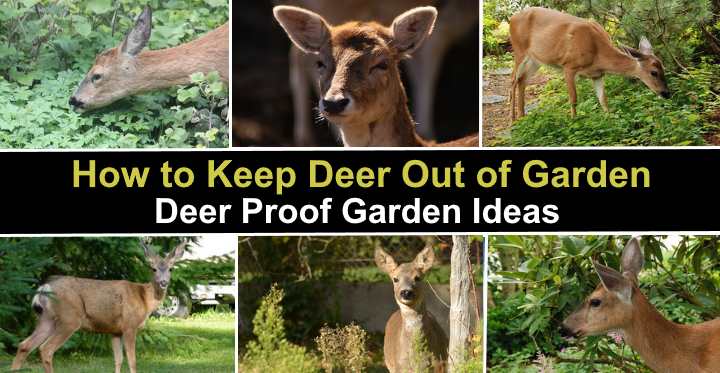
Knowing how to keep deer out of a garden is vital to protect your ornamental plants, flowers, shrubs, trees, and lawn. Although deer are adorable animals in woodlands, forests, and films, deer damage can devastate gardens. To create a deer-proof garden, it’s vital to use a range of deterrent methods. A combination of repellents, planting deer-proof plants, and a fence may be necessary to help keep deer away from your garden.
White-tailed deer and mule deer are becoming problematic for many gardeners. As towns and cities expand, the native habitat for deer decreases. Also, a lack of food can bring deer into gardens in search of tasty treats. Unfortunately, some of the most beautiful decorative garden plants are also on the menu for these hungry hoofed animals.
Deer are attracted to easily digestible plants. Delicious deer nibbles include young tender leaves, fresh grasses, fruit, and new woody growth on shrubs and trees. But, there are also aromatic, fibrous, and toxic plants that deer tend to avoid. So, it makes sense not to plant any type of foliage plants that deer like to eat.
This article is a guide to knowing how to keep visiting deer out of your garden. Ideas about deer repellents, deer fencing, and plants that deer hate can help you create a deer-proof garden.
Deer Proof Garden Ideas

Keeping deer out of your garden requires a combination of preventive methods
To keep deer away from your garden requires a combination of preventive techniques. First, growing deer-resistant plants and spraying DIY repellent can prevent deer from munching on foliage. Additionally, some strong-smelling flowers have a deer-repelling action. Finally, it may be necessary to protect your garden and plants using deer fences or netting.
To avoid frustration when trying to stop deer from intruding in your yard, it’s good to be realistic about the methods. Researchers say that no plant is 100 percent deer-resistant when food is scarce. Deer will feed on any plant if they are hungry or need to feed their young.
However, many plants with pungent aromas will discourage deer from paying a visit to your property. Also, some home remedy tactics to deter deer may work in some areas.
Deer Proof Garden by Planting Deer Resistant Plants
A cost-effective way of deterring deer from your garden is to grow plants that deer don’t like. Sometimes, a “trial and error” method helps to find effective deer repellent plants for your area. Typically, plants with coarse or fuzzy leaves, bitter plants, and fibrous plants are not attractive to deer.
If deer are a nuisance in your area, you must avoid plants that attract deer. According to the Michigan State University, plants such as hosta, daylilies, petunias, impatiens, Japanese maples, some evergreen shrubs, rose, and herbaceous plants are the types of appetizing garden delights deer love munching on.
There are plenty of flowering perennials and annuals you can plant in a deer-proof garden.
Plants with fuzzy leaves deter deer from eating them

Lamb’s ear is a deer repellent plant due to its furry leaves
Deer detest plants that have furry or hairy leaves. If you want to avoid your flower bed from becoming a snack bar for deer, grow plants with fuzzy foliage. Some suitable plants are lamb’s ear (Stachys byzantina), tuberous begonias (Begonia × tuberhybrida), yarrow (Achillea), lady’s mantle (Alchemilla), and heliotrope (Heliotropium).
Grow prickly plants to keep deer away
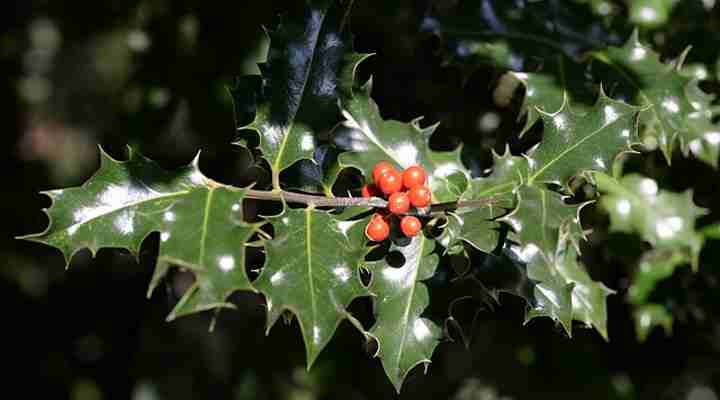
The thorny leaves of holly shrub help to deter deer from eating them
Another excellent way to deer-proof a garden is to grow plants with thorns, spines, spikes, and jaggy leaves. Plants that can prevent your garden from becoming the local deer salad bar include the following:
- Holly (Ilex)
- Bear’s breeches (Acanthus)
- Globe thistle (Echinops)
- Barberry (Berberis)
Plant deer-proof plants that have toxic foliage

All parts of monkshood (Aconitum) are poisonous and are deer resistant
Deer stay clear of shrubs, bulbous plants, and ornamental perennials that have toxic leaves. Deer quickly learn which plant leaves gives them a stomachache. Flowers to keep deer away include Monkshood (Aconitum), foxglove (Digitalis), lupin (Lupinus), poppies, dusty miller (Artemisia stelleriana), and larkspur (Delphinium).
Deer rarely eat plants with leathery or fibrous foliage
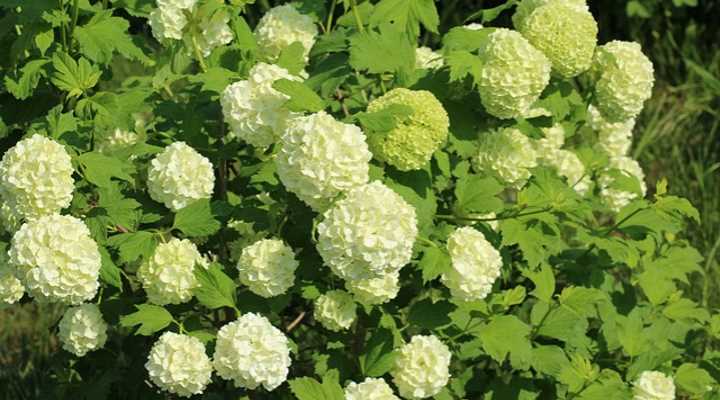
Although deer eat viburnum shrubs, they prefer the tender new growth
Deer prefer munching on young, tender leaves that are easy to digest. Therefore, they stay away from plant leaves with a leathery texture or fibrous foliage. Some plants that deer try and avoid include wax begonias, elephant ears (Alocasia and Colocasia), most species of irises, and some viburnum shrubs.
Keep Deer Out of Garden Using Deer Repellent Plants
Unfortunately, there are no plants that are entirely deer-proof. However, many types of plants are avoided by deer if they have plenty of other tasty options. Some plants give off strong odors that deer detest. Unless food is scarce, deer tend to avoid many aromatic shrubs and flowering plants.
Plants with strong scents help repel deer

Plants with strong scent repel deer, for example (clockwise from top left): marigolds, verbena, butterfly bush, catmint, peony and bee balm
Deer have a keen sense of smell and they stay away from flowering perennials and annuals with pungent aromas and scents. Types of strong-smelling plants that deer only eat as a last resort include the following:
- Marigolds (Tagetes)
- Verbena
- Bee balm (Monarda)
- Peonies (Paeonia)
- Black cohosh (Actaea racemosa)
- Butterfly bush (Buddleja)
- Russian sage (Salvia yangii)
- Boxwood shrubs (Buxus)
- Catmint (Nepeta)
Also, most types of flowering herbs are not favorite delicacies of deer. Suitable herbs for a deer-resistant include oregano, lavender, sage, and thyme.
There are many spring bulbs that deer stay clear of because of their taste. Among the flowering deer-repelling bulbs are autumn crocus, daffodil, and allium. However, if deer are pests in your yards, avoid planting tulips.
Keep Deer Out of Garden Using Deer Fence
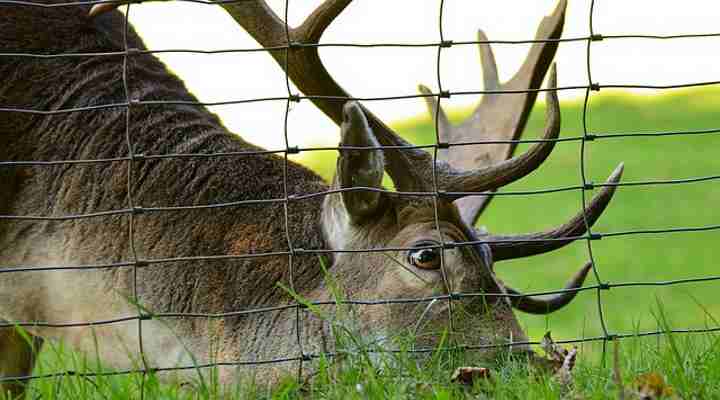
Deer fence is an effective method to keep deer out of garden but can be expensive
Fencing around a garden, vegetable patch, or flower bed is the only way to avoid deer damage in front or backyards altogether. But remember, deer can jump 8 ft. (2.4 m) high. Therefore, any fence to keep deer out of gardens ideally should be at least 10 ft. (3 m) tall.
Unfortunately, erecting a deer fence around a property can be an expensive deterrent.
In some cases, building a stockade fence is an ideal deterrent to keep deer out of your garden and protect your plants. With a stockade fence to block deer, it can be six feet (1.6 m) high. This is because deer prefer to see what’s on the other side before they leap into your garden.
However, a stockade fence can be more expensive than a standard deer-resistant mesh fence around your property.
Here are a few cheaper options to fence your property to prevent deer damage.
Use electric fence if deer are a menace in gardens
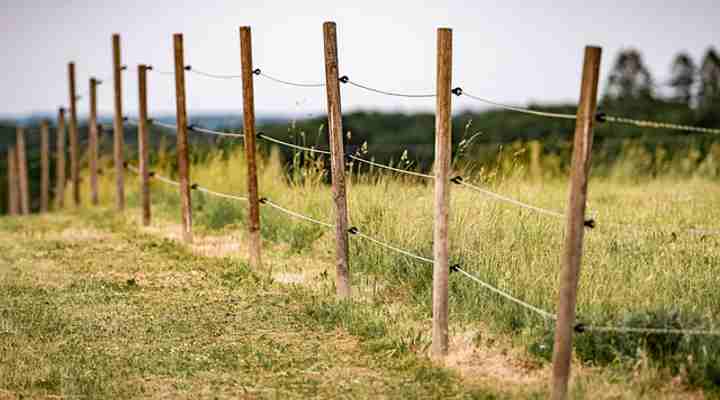
Electric fence keeps deer out of garden but can be costly
Depending on your yard and local zoning laws, an electric fence is an excellent deer deterrent. The deer learn to keep off your property when they touch the electrified wires. For some homeowners, installing an electric deer fence is an expensive undertaking.
When installing an electric fence to deer-proof your garden, it’s a good idea to bait the fence with peanut butter. This attracts the deer to taste the sweet treat but delivers a shock. In time, deer stay away. So unless you bait the electric deer fence, you’ll need to install a 10-foot (3-m) fence—otherwise, deer will just jump over it.
Some companies produce wireless electric fences as cost-effective deer repellents. The sweet aromas attract deer who sniff the electronic posts. The mild electric shock teaches them to stay away from your garden.
Protect gardens by growing a living deer-resistant hedge
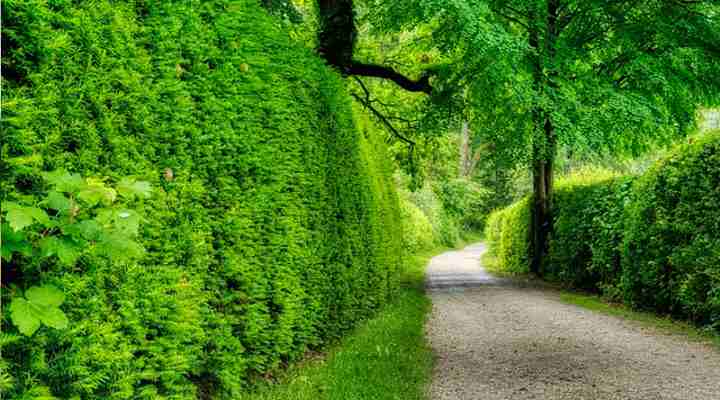
Living fence helps prevent deer from coming into your garden
Many evergreen hedging plants such as boxwood, eastern red cedar, Chinese juniper, and inkberry are ideal for keeping deer out of gardens. The dense evergreen foliage means that deer can’t see what’s on the other side. This makes them less likely to leap into your yard to enjoy their evening snack.
There are a few things to remember about using a living hedge to keep deer out of gardens. First, the privacy screen should be at least 6 feet (1.8 m) tall to be effective. Second, you must maintain the hedge well. Deer can squeeze through small gaps if there are tasty flowers and shrubs in your garden.
Use deer netting to protect individual plants from deer damage
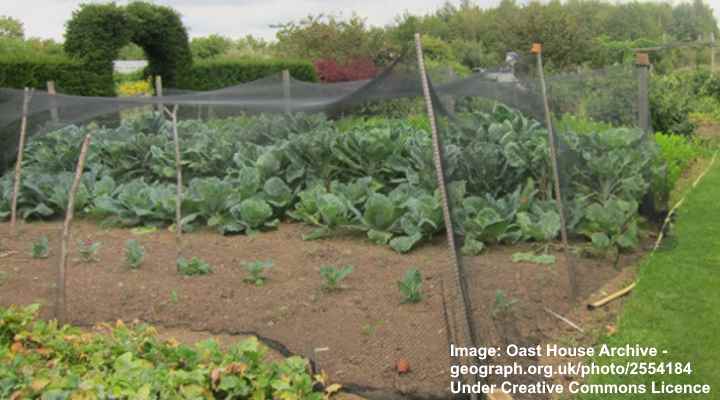
Fencing your vegetable patch will keep away deer from eating the plants
Putting nets over individual bushes, shrubs, bulbs, and ornamental plants can stop deer from feeding on them. Deer-proof mesh can be cheaper and more effective than fencing a whole property. Keeping shrubs constantly under netting can protect their foliage from deer damage. It also means you don’t have to protect deer-resistant garden plants.
Deer Proof Garden by Using Deer Repellents
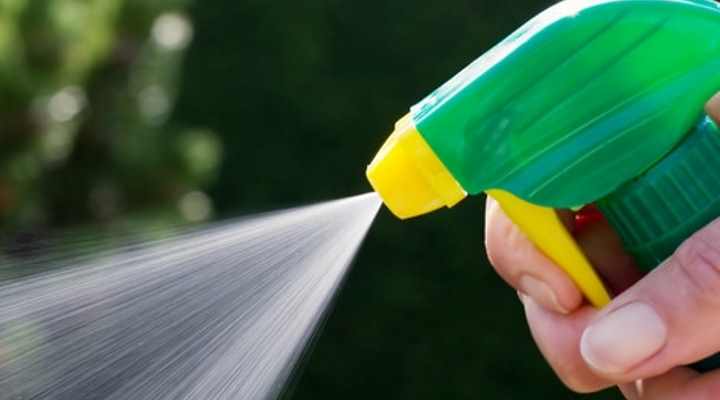
Deer repelling spray help to deter deer from munching your plants
Many types of deer repellent sprays are effective if you use them properly. However, in many cases, deer repelling sprays must be applied at least weekly and after rainfall if you want to stop deer from chomping through your prized ornamental plants. Also, effective deer repellents for garden plants should have a pungent odor and taste bad.
The time to use deer repellent on plants is from fall until early spring. This is when deer most commonly venture into gardens looking for food. Applying the deterrents on plants before deer start feeding helps prevent them from returning to your yard.
Popular and effective deer repellents are made from rotten eggs, dried blood, smelly soap, or garlic
Commercial Deer Repellents to Protect Garden Plants
Many commercially available deer deterrents can help reduce deer damage in gardens.
One study found that egg-based repellents were most effective in stopping deer from eating plants. However, using ingredients such as chili, foul-tasting substances, and soaps can bring about aversion in deer when applied to plants. The repellents work on four principles for deer prevention—fear, aversion, taste, and pain.
According to the research, effective deer repellent brands are Bobbex and Hinder. However, researchers found that no repellent can prevent 100 percent of foliage damage. Also, it’s vital to follow the manufacturer’s recommendations when applying sprays to deter deer.
DIY Natural Deer Repellent for Deer-Proof Gardens
You can also create your own natural deer repellent to protect decorative shrubs, flowers, ground cover plants, and bushes. Any homemade repellent for deer protection should work on the same scientific principles as commercial repellents—create a bad-tasting solution to spray on plants.
Deer repellent recipe:
To make a DIY deer repellent, you will need 8 habanero peppers, half a cup of water, 2 tbsp. vegetable oil, and 6 tablespoons of natural yogurt. For the next step, blend the chili peppers in water and strain through a cheesecloth. Then combine the pungent solution with the oil and yogurt. Finally, mix 1 part of the homemade solution with 10 parts of water in a spray bottle.
To protect your plants from deer damage, use the deer spray weekly on plant foliage in your garden. Reapply after rainfall.
Other Repelling Methods to Help Keep Deer Out of Gardens
Other methods of discouraging deer from viewing your garden as an all-you-can-eat buffet may have varying levels of effectiveness. Some methods using pungent odors or scare tactics can work for a time. However, deer may get used to your tricks and start to ignore them.
Here are a few methods you can try to keep deer away:
Scented deer repellents

Deer seem to be put off by the small of Irish spring soap
Some gardeners say that they have success by using Irish Spring soap. Although this smell pleasant to most people, deer seem put off by it. You could try grating the soap and sprinkling it around your garden. Other people suggest hanging cubes of soap on strings from trees. However, you will still need to spray plants to help keep deer away.
Human hair is another scent that is said to scare rabbits and deer. There is no evidence that hair clippings or small bags of human hair work as a deer deterrent. However, if you know a hairdresser, you could ask for clippings to see if it works in your area.
Visual or auditory deer repellents
Wind chimes or a string of CDs hanging from trees could startle deer and cause them to flee. Although these methods may work at first, deer will get used to them and end up ignoring them.
Some online sellers advertise solar-powered deer deterrent LED lights. The red LEDs mimic a predator’s eyes and flash in random patterns so that deer don’t get used to them. One of these light deterrent benefits on deer is that they work at nighttime when the four-legged garden pests do the most garden damage.
Keep Deer Out of Garden by Scaring Them
Deer are cautious animals and tend to be easily scared. There are several ways to frighten deer so that they scamper away from your garden. Here are some ways to scare deer from your property:
Motion-activated sprinklers can scare deer
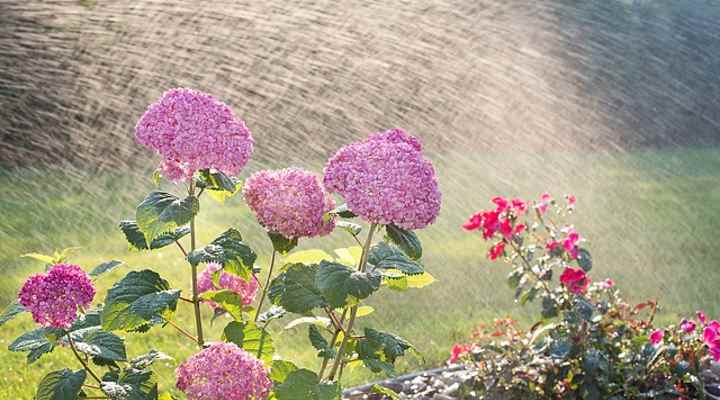
Motion sprinklers can scare off deer, preventing them from entering your garden
Called yard enforcers, sprinklers that switch on when they detect motion can help to get rid of deer and other critters from your yard. The sprinklers are attached to sensors and will send a strong blast of water if anyone comes near. The best yard enforcers work night and day and spray water in a 120° arc motion.
If you have a large yard, you can install the sprinklers in strategic locations to humanely target deer when they approach your property.
A dog can scare off deer

Your dog can scare off and deter deer
If you own a dog, allowing your dog to roam the yard can help keep deer away. Apart from chasing wild animals that enter your property, the scent of a dog can act as a deer deterrent. For example, dog hair and urine deter deer and other wildlife.
Other Ways to Create a Deer-Proof Garden
Discouraging deer from your yard requires vigilance and using a combination of deterrent and repelling methods. Here are a few more ways that you can stop deer from nibbling your plants:
Install tree wraps to protect trees from deer damage
Tree wraps can help protect tree bark from deer stripping it or destroying it with their antlers. You can install metal mesh, chicken wire, or thick plastic sheeting to stop deer coming into contact with the trunk to protect a tree. Install the protective tree wrap around the trunk, a few inches away from it.
Use fishing line around flower beds to deter deer
Creating a physical, almost invisible barrier around flower beds can protect your ornamental landscaping plants. You will need sturdy posts to string fishing line taut around it. Keep the fishing line about 2 to 3 ft. (0.6 – 1 m) above the ground. Ensure that the line is far enough from your plants so that deer cannot lean over and chew plant foliage.
Related articles:
